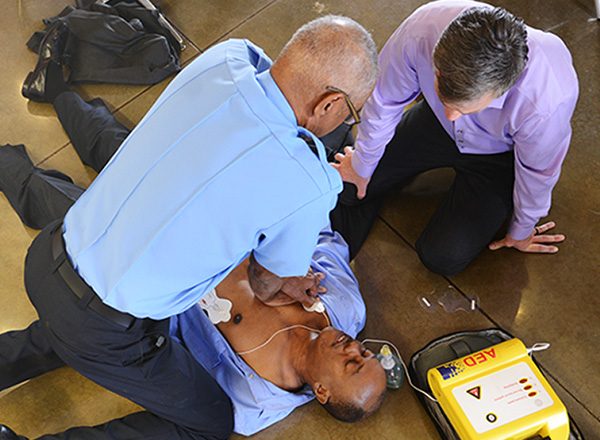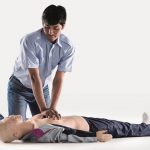Modern hospitals typically sprawl over massive campuses. They provide a wide spectrum of services from intensive care to outpatient clinics to administrative services and even retail shopping, food services, parking, maintenance, parks, and religious spaces.1 If a visitor or staff member suffered a sudden cardiac arrest in these areas, are all of your employees prepared to help?
While you may expect that visitors and staff would experience stronger survival outcomes after a sudden cardiac arrest on a hospital campus than patients, that expectation may not always be the case.
Approximately 292,000 in-hospital cardiac arrests occur annually in the United States alone, according to an article from the American Heart Association publication Circulation: Cardiovascular Quality and Outcomes. The study reflects how approximately 1-4% of cardiac arrests will occur to non-patients — visitors or staff — in public areas of the hospital.2 Studies show that the need for resuscitation education extends beyond clinical staff.
At RQI Partners, we believe everyone should at least know how to recognize a sudden cardiac arrest, know what to do, and deliver hands-only CPR until help arrives. That’s where RQI Responder can help. Training non-clinical staff to recognize a cardiac arrest, call for help, and deliver high-quality, hands-only CPR can strengthen the chain of survival for sudden cardiac arrest victims.
The difference RQI Responder education offers to all staff
Cardiac arrest response may be slower for a hospital visitor when compared to public arrests in other high traffic buildings such as airports, casinos, or schools. One small study suggests that response time to cardiac arrest situations in public areas of the hospital can indeed be much slower than for inpatients in the same hospital. The average time to defibrillation for the public area cohort was significantly longer than for the in-hospital arrest control group (12.3 vs 2.5 minutes, p <0.0001).3
What is RQI Responder?
A rational behind the need for ancillary staff to be trained in hands-only CPR to protect visitors and staff in public areas of a hospital from death caused by a sudden unexpected cardiac arrest.
Even with Public Access Defibrillator (PAD) programs in public areas of hospitals, delay to AED application by a trained responder can exceed 3 minutes — critical minutes.
RQI Responder is a specific course created to meet the need of the non-clinical staff. It is designed to prepare staff not directly involved in patient care the education to respond to a cardiac arrest effectively and efficiently in the first 2-3 minutes. This education helps non-clinical support staff know what to do in case one of their colleagues, or a visitor to your hospital, collapses from cardiac arrest.
This skill also transfers to their community and home. With 70% of out-of-hospital-cardiac-arrests (OOHCA) occurring in a home, your staff members will also learn how to protect their loved ones. The educational value extends beyond the workplace and offers elements of community outreach, while also supporting overall organizational safety.
RQI Responder education extends beyond the workplace
The RQI Responder course offers a cost-effective, convenient, and mission-oriented program to add to CPR education. This bi-annual adult, hands-only CPR course covers the essentials for ancillary staff to recognize and appropriately respond to a sudden cardiac arrest in the non-patient, public areas of a hospital where clinical staff may not be readily available.
On December 13, 2007, Congress unanimously passed a resolution to set aside June 1-7 each year as National CPR and AED Awareness Week to highlight how lives can be saved if more Americans know CPR and how to use an AED. We invite you to celebrate National CPR and AED Awareness Week by reinforcing the importance of all staff and bystanders to be trained to act in a cardiac arrest emergency.
Every staff member can learn and grow their lifesaving skills, even if they do not have a heroic title. With this skill, we believe they will be more connected with colleagues, as well as organizational missions and values.
1 Adams BD, Jones RJ, Delgado RE, Larkin GL; American Heart Association National Registry of Cardiopulmonary Resuscitation Investigators. Cardiac arrests of hospital staff and visitors: experience from the national registry of cardiopulmonary resuscitation. Resuscitation. 2009 Jan;80(1):65-8. doi: 10.1016/j.resuscitation.2008.09.016. Epub 2008 Dec 10. PMID: 19081663.
2 Peberdy MA, Kaye W, Ornato JP, et al. Cardiopulmonary resuscitation of adults in the hospital: a report of 14720 cardiac arrests from the National Registry of Cardiopulmonary Resuscitation. Resuscitation 2003;58:297—308.
3 Adams BD. Cardiac arrest of nonpatients within hospital public areas. Am J Cardiol. 2005 Jun 1;95(11):1370-1. doi: 10.1016/j.amjcard.2005.01.086. PMID: 15904647.








